There were two principal stages of gold mineralization in the Otago Schist basement: Jurassic-early Cretaceous, as at Macraes, and middle Cretaceous. The vein system at Oturehua is part of the latter group. The Oturehua vein system formed on the northeast margin of the Otago Schist belt, and is approximately along strike from the Macraes deposit (see map below), but has an entirely different structural origin. The Oturehua veins were emplaced during regional tectonic extension, rather than being emplaced during thrusting as at Macraes.
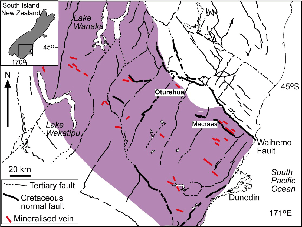 Summary geological map of the Otago Schist (purple) with the principal gold-bearing vein systems (red). Major Cretaceous normal faults are heavy black lines. Gold-bearing structures near the northeast margin of the schist belt include the Macraes mine and the vein system at Oturehua.
Summary geological map of the Otago Schist (purple) with the principal gold-bearing vein systems (red). Major Cretaceous normal faults are heavy black lines. Gold-bearing structures near the northeast margin of the schist belt include the Macraes mine and the vein system at Oturehua.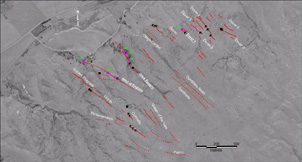 Map, superimposed on an aerial photograph, of the Oturehua vein system (red). The Golden Progress historic site is at centre left. Historic mine sites are indicated with symbols on the veins. The Central Otago Rail Trail crosses the top left corner of the image.
Map, superimposed on an aerial photograph, of the Oturehua vein system (red). The Golden Progress historic site is at centre left. Historic mine sites are indicated with symbols on the veins. The Central Otago Rail Trail crosses the top left corner of the image.Gold mineralisation at Oturehua was controlled by northwest-striking normal faults that developed from coalescence of scattered, steeply dipping extensional fractures in lower greenschist facies schist. Formation of these mineralised faults was facilitated by structural preparation of the rock mass in the hinge of a kilometre scale post-metamorphic antiform and associated outcrop-scale kink folds. However, the mineralised faults and associated extensional fractures were not directly controlled by any specific structural elements of the kink folds.
Oturehua vein swarm
A set of more than 50 mineralised normal faults cuts the schist at Oturehua. The faults strike northwest and dip steeply (>60°) northeast, and individual mineralised zones are traceable for up to 700 m along strike. Mineralised faults contain 10-100 cm thick quartz veins that are traceable as interlinked structures for tens of metres along strike. The mineralised faults formed in the hinge of a northwest trending post-metamorphic antiform, and the faults may have been localised by zones of weakness associated with kink folding in the hinge of the antiform. Hydrothermal fluids responsible for mineralisation were channelled by the normal faults.
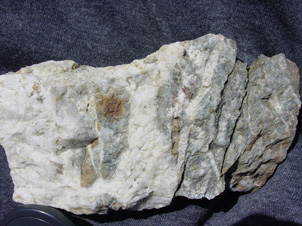 Photograph of a piece of mineralized quartz vein material (white) from Oturehua, with grey silicified schist breccia fragments. Oxidised pyrite and arsenopyrite in the central breccia fragment forms a brown patch. Gold is associated with these sulphide minerals. Orange-brown staining of the silicified breccia at right is due to oxidation of hydrothermal iron-bearing carbonate (ankerite).
Photograph of a piece of mineralized quartz vein material (white) from Oturehua, with grey silicified schist breccia fragments. Oxidised pyrite and arsenopyrite in the central breccia fragment forms a brown patch. Gold is associated with these sulphide minerals. Orange-brown staining of the silicified breccia at right is due to oxidation of hydrothermal iron-bearing carbonate (ankerite).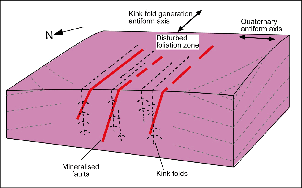 Sketch block diagram (about 3 km wide) showing the key structural features of the Oturehua vein system. The veins occur on a broad shallow Quaternary antiform that trends northeast. This antiform folds a tighter northwest-trending antiform that folded the schist foliation in the middle Cretaceous. Kink fold zones developed in the hinge of the Cretaceous antiform. Mineralised veins were partly controlled by these kink fold zones, but cut across the structures at the outcrop scale.
Sketch block diagram (about 3 km wide) showing the key structural features of the Oturehua vein system. The veins occur on a broad shallow Quaternary antiform that trends northeast. This antiform folds a tighter northwest-trending antiform that folded the schist foliation in the middle Cretaceous. Kink fold zones developed in the hinge of the Cretaceous antiform. Mineralised veins were partly controlled by these kink fold zones, but cut across the structures at the outcrop scale.Oturehua vein minerals
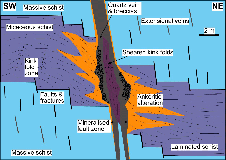 Composite sketch showing the control of different schist rock types on the style of gold mineralisation at Oturehua. Massive schist layers (light blue) fracture readily and encourage quartz vein formation, but have been chemically unreactive during hydrothermal emplacement of the veins. In contrast, well-layered micaceous schist )dark blue) has developed kink folds and breccias, wider mineralisation zones, and alteration by iron-bearing carbonate (ankerite, orange)
Composite sketch showing the control of different schist rock types on the style of gold mineralisation at Oturehua. Massive schist layers (light blue) fracture readily and encourage quartz vein formation, but have been chemically unreactive during hydrothermal emplacement of the veins. In contrast, well-layered micaceous schist )dark blue) has developed kink folds and breccias, wider mineralisation zones, and alteration by iron-bearing carbonate (ankerite, orange)
The style of vein mineralization at Oturehua was strongly controlled by schist rock types on the 1-10 m scale, as summarized in the diagram below. Massive schist layers are relatively rich in quartz and feldspar and have relatively little muscovite. Where massive schist is cut by mineralised faults, there has been little wall rock alteration (cm scale only), and the faults are filled with quartz veins that are largely planar, with scattered sulfide minerals and visible gold. In contrast, laminated schist, which is relatively rich in muscovite and chlorite, has been extensively folded, sheared, and altered adjacent to mineralised faults. Alteration involved silicification (addition of quartz) and ankeritic carbonate replacement of chlorite by kaolinite and/or sericitic muscovite, plus extensive addition of gold-bearing sulfide minerals, mainly arsenopyrite. Veins in the mineralised faults cutting laminated schist contain abundant breccia fragments that have been variably hydrothermally altered. The boundaries between mineralised veins and altered laminated schist are commonly diffuse.
Comparison to Macraes gold
The Oturehua mineralised faults are the nearest mineralised structures to the northeast margin of the Otago Schist belt, and have formed in the footwall of the Waihemo and/or Blue Lake Fault Zones. Mineralised faults and extensional fractures developed during Cretaceous regional extension in the footwall of these northwest-striking regional normal faults, which juxtaposed rocks of differing metamorphic grade during tectonic unroofing of the Otago Schist belt. Remnants of sediments deposited during that extensional unroofing (Kyeburn Formation) are preserved only 10 km northeast of the Oturehua mineralised faults. The Oturehua mineralised fault system preserves evidence of hydrothermal activity and gold mobility that was active in the shallow crust during this regional extension event. The style of mineralisation at Oturehua is distinctly different from the older compressional late-metamorphic mineralised structures of the Macraes mine that are also close to the northeast margin of the Otago Schist belt.
More information
- Mackie, C, MacKenzie, D & Craw, D. 2008. Structure and mineralization of gold-bearing veins at Oturehua, central Otago. AusIMM New Zealand Branch Conference, Wellington. Pp 291-299.
- Mackie, C, MacKenzie, D J & Craw, D. 2009. Structural and lithological controls on gold mineralization at Oturehua on the northeastern margin of the Otago Schist, New Zealand. New Zealand Journal of Geology & Geophysics 52: 43-47. doi:10.1080/00288300909509877
- Mortensen, J K, Craw, D, MacKenzie, D J, Gabites, J E & Ullrich, T. 2010. Age and origin of orogenic gold mineralisation in the Otago Schist belt, South Island, New Zealand: Constraints from lead isotope and 40Ar/39Ar dating studies. Economic Geology: 105: 777-793. doi:10.2113/gsecongeo.105.4.777
Related
- Crustal structure and topography of the Otago northeast margin
- Initiation of the fault zones on the northeast Otago margin
- Faulting and erosion of the Macraes gold deposit
- Gold-bearing veins at Oturehua
- Blue Lake Fault Zone
- Graphite and gold on the northeast schist margin
- Gold and arsenic in pyrite
- Waipounamu Erosion Surface
- Alluvial gold along the northeast Otago margin
- Rise of modern mountains on Otago's northeast margin
- Patearoa gold: Alluvial concentrations in a dynamic environment